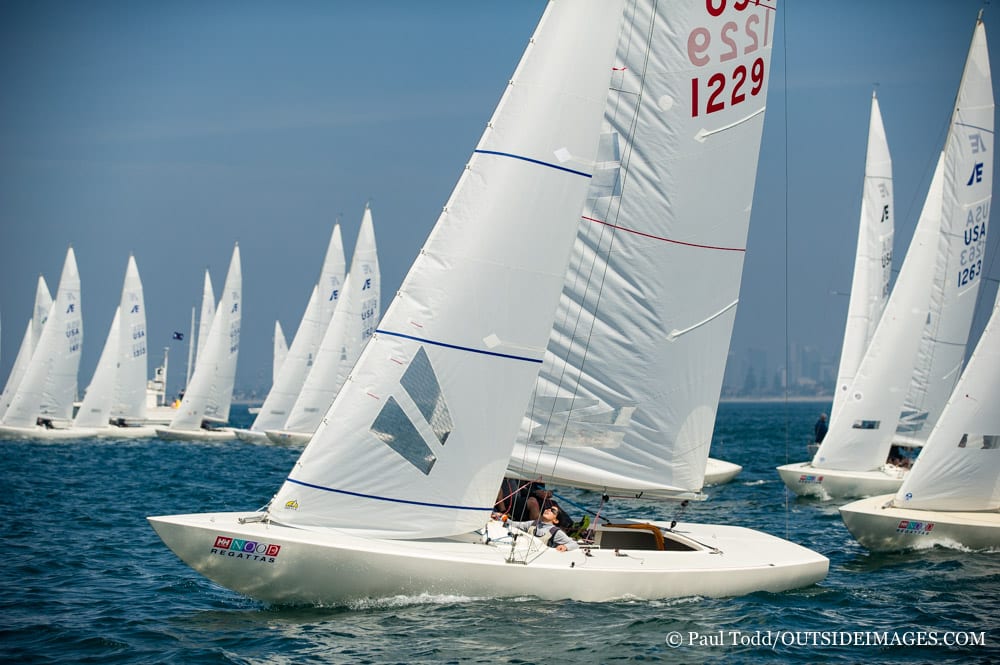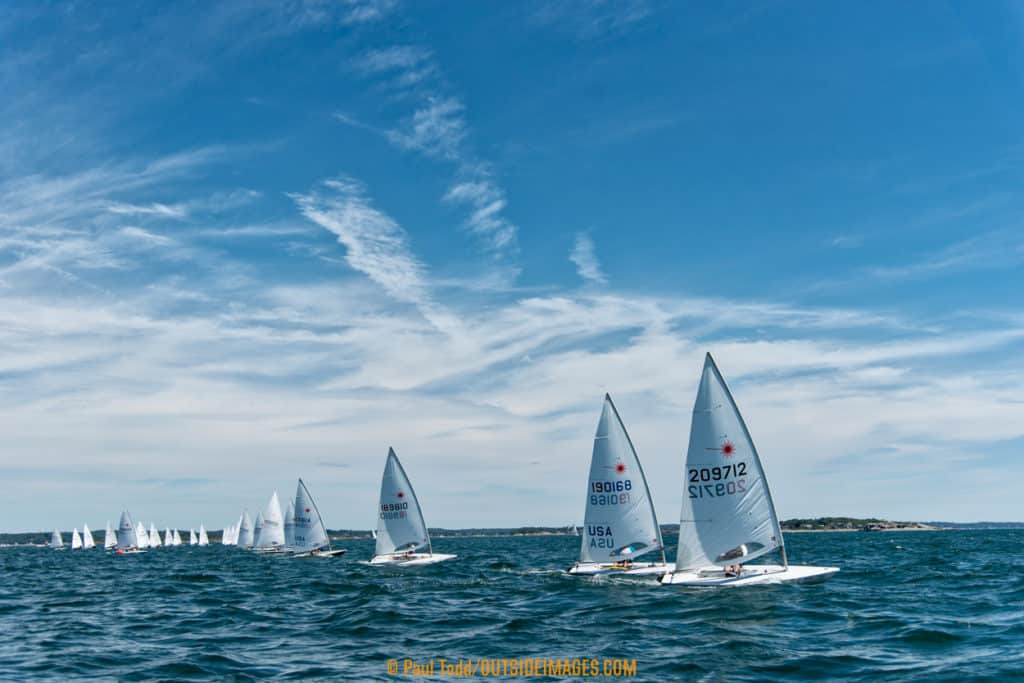
In another column, “Review Your Options“, I discussed my failure to properly analyze and manage a “two winds simultaneously” situation during the Soling Worlds and promised a second analysis. After writing that article I wondered if I’d been describing a situation so unusual that it couldn’t fit in one of the standard categories – Oscillating Shifts, One Side Advantaged or None of the Above – and that after more than 20 years during which my simple categorization scheme had served me well, a fourth category was needed.
In the fifth race I’d mistakenly expected the TWS condition existing at the 3:00 p.m. start would be transient, that the sea breeze, which had invaded the southern edge of the course, would lift the westerly gradient from the surface and spread over the entire course. When the back appeared and I was able to cross the fleet on port at the start, I recognized we had a TWS condition, but expected it to be temporary, that the sea breeze side of the course would become advantaged.
Most persistent shifts are characterized initially by a transient TWS. The new wind, typically colder than the wind it replaces, appears at one edge of the course, undermines and reduces the strength of the old wind. When its surface flow gradually increases in velocity it spreads across the course. As the old wind is displaced, the shift (abrupt or gradual) is toward the new wind and, if on a beat, an affected boat must be headed toward the new wind. In most parts of the world, new winds that develop just before or during a daytime race are sea or lake breezes (or late-in-the-day gradient winds returning to replace sea or lake breezes). The same Category II condition can also be created by the appearance of an upslope or downslope wind, by the appearance of a new gradient wind, by the down flow from a thunderstorm, by the separation of the over-water flow from the overland segment of a parallel-to-shore gradient wind, and by the separation of the surface elements of a sea breeze coming at water level around a point from its overland elements coming off the point.
The question is whether the TWS state resulting from the invasion of a new wind will be intermittent, resulting in oscillating shifts between the new wind and the old, or temporary, with the new wind spreading across the course to produce a classic persistent shift. The third consideration is whether the TWS will persist. The first scenario is a rare TWS condition in which two winds alternately occupy and then recede from the entire course resulting in a series of oscillating shifts. It only occurs when a strong down-slope wind intermittently breaks through geographic barriers along the slope, when a parallel-to-shore flow with water on its left divides into segments, or when a sea breeze comes around and over a point and the warmer but stronger overland segment intermittently displaces the over-water segment.
The important distinction between the possibilities No. 2 and No. 3 above is the new wind’s effect on the wind at the weather mark. In a classic persistent shift, the new wind displaces the old wind from the entire course area, becomes the wind at the weather mark, and requires sailing toward the new wind initially so as to get upwind in that wind. If, however, the new wind fails to spread across the course and the old wind remains the wind at the weather mark, one must sail toward the old wind initially so as to approach the weather mark upwind in it. Selecting the correct tack is extremely important, but as I wrote last month, this is not obvious, so you should look around until the correct tack becomes obvious. It is, however, possible to predict the correct tack in advance by determining which wind will be present at the weather mark when you get there.

TWS conditions may result from the encroachment of new winds of any of the types that create persistent shifts (sea/lake breezes, upslope and downslope winds, thunderstorms, invading gradient-wind flows, new gradient winds, parallel-to-shore flows, and overland sea breezes) as well as from channeling of the near-shore wind around shoreline features. TWS conditions occur when the new wind’s temperature is approximately the same as the old wind’s temperature so that the new wind is unable to completely lift and displace the old. You should be able to predict new wind development and the likelihood that it will or will not become the wind at the weather mark by considering the temperature of the two winds involved. If the new wind is a sea breeze coming off cold water toward a hot offshore flow-think San Francisco in mid-summer-the old, hot-air flow will be lifted off the surface and fully displaced; the wind at the weather mark will become the new wind-a classic persistent shift. If the temperatures of the two winds are similar or the new wind is warmer, the new wind will be unable to undermine and lift the old wind from the surface, the two winds will remain separated, occupying different portions of the course, and the wind at the weather mark will be the old wind.
During a race in which a new wind is expected, one should watch for a zone of calm developing between the two winds. If this zone is narrow and moves rapidly across the course, a persistent shift is likely developing and the wind at the weather mark will become the new wind. If the zone of calm is broad and persists in the same location, the new wind is likely unable to undermine the old and the weather mark should remain in the old wind. If the persistent zone of calm lies between the leeward mark and the weather mark, the wind at the leeward mark must be different from that at the weather mark.
Finally, we can consider (what may be the most valuable means of determining the nature of the wind at the weather mark) the behavior of the race committee, which is monitoring the wind at the weather mark. They know which wind is present there when you’re rounding the leeward mark. If a shift greater than 15 degrees, which is typical of new winds, occurs there, they will signal a change in course; if not, they won’t.
If they signal a change in course for the second round, but the wind at the leeward mark has not yet shifted (or only shifted slightly), the wind at the weather mark is the new wind and you should head for it. If they signal a change in course and the wind at the leeward mark is already shifted to the new wind direction, you should take the lifted tack away from the new wind direction, as this indicates the new wind is already present at the weather mark and the most likely next shift will be an oscillation back toward the old wind. If the wind at the leeward mark has shifted to a new wind and they do not signal a change in course, the wind at the weather mark is still the old wind and you should head for it.
The other consideration in TWS is to cross the zone of calm at its narrowest point. It may pay to move upwind in the wind that is available until you reach a narrower site at which to cross, but you should never go beyond the old-wind layline.
This article first appeared in the June 2007 issue of Sailing World.









